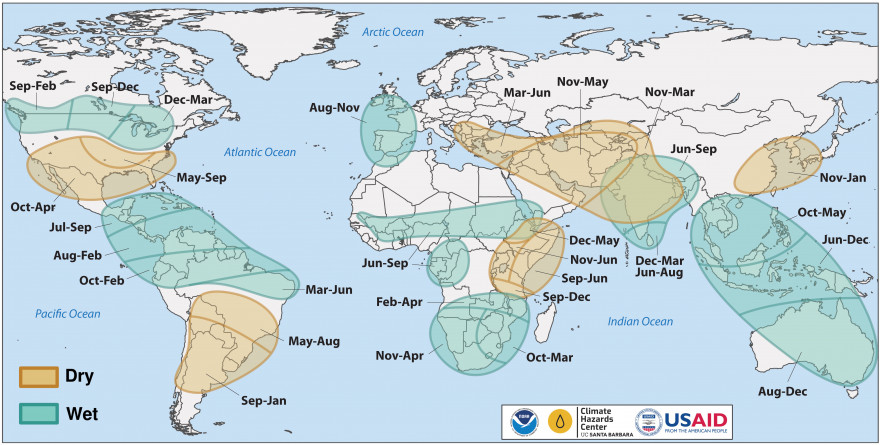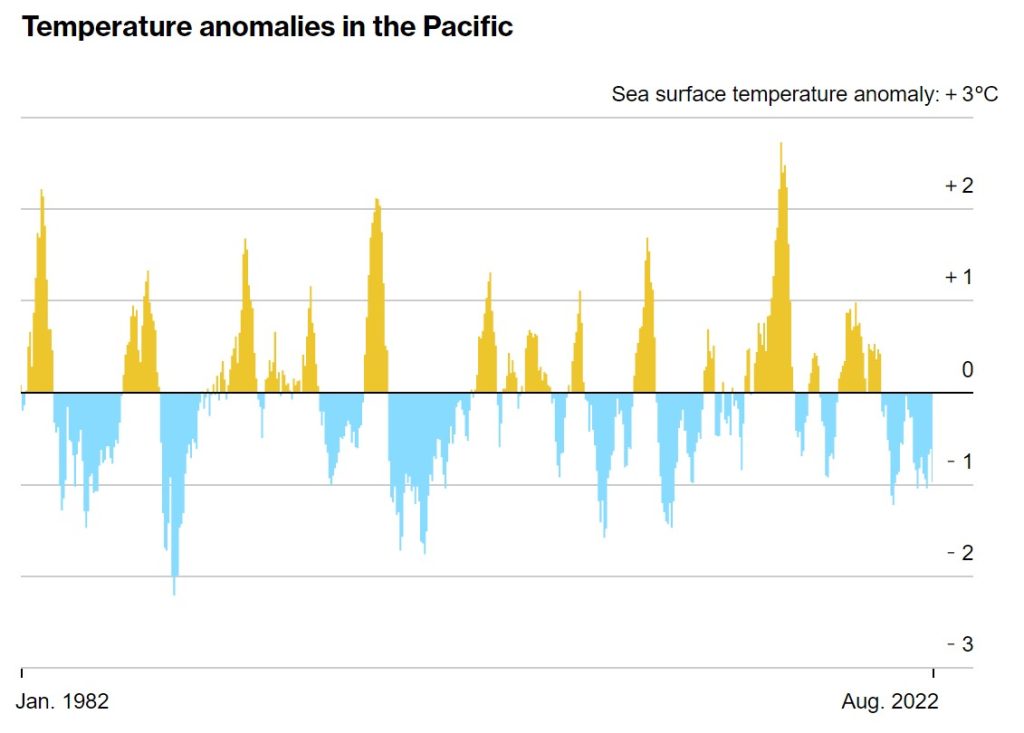It’s all but guaranteed the world will see another year of weather disasters
that destroy homes, ruin crops, disrupt shipping and threaten lives.

Unprecedented monsoon floods in Pakistan. Scorching heat and wildfires in the US West. Torrential rains in Australia and Indonesia. A megadrought in Brazil and Argentina.
Weather disasters across the world are reaching new extremes. According to scientific studies, it’s La Nina, an atmospheric phenomenon, that has been the driver behind the chaos since mid-2020. And now the planet stands on the cusp of something that’s only happened twice since 1950 – three years of La Nina.
Another year of La Nina means the world is hurtling toward $1 trillion in weather-disaster damages by the time 2023 wraps up. The floods, droughts, storms and fires will destroy more homes, ruin more crops, further disrupt shipping, hobble energy supplies and, ultimately, end lives.
In case of a natural disaster, drinking water is very important. I would either have a large stock a water bottles or have a portable water filte that works…
It’s hard to imagine that all this destruction comes down to just a slight drop in temperatures way out in the gleaming blue waters of the equatorial Pacific Ocean.

On a patch of ocean frequented by seals and fishing crews, less than a degree of cooling can bring on La Nina and upend the world’s weather. While the warm-cool ocean cycles have been happening for centuries, La Nina now means something more intense than ever before because of the way that climate change magnifies its calamities.
During the next weather disaster you may lose your electricity… You will never be in the dark again with this portable power station……
The weather cycles that come from La Nina “just exacerbate all the problems that already exist in the big picture, like the war in Ukraine and rising commodity prices,” said Michael Pento, president and founder of Pento Portfolio Strategies. “When you add in the extreme weather, it just creates a scenario for higher energy prices, higher food prices and more inflation. It’s negative for the global economy, and it’s working against the Federal Reserve.”
Here for Australia:
Odds that the cooling of the equatorial Pacific will linger through October have risen to 97%, according to a new forecast by the US Climate Prediction Center. The chances of La Nina sticking around through January are 80%.
The last string of three La Ninas was 1998-2001, and before that 1973-1976, according to Michelle L’Heureux, a forecaster and scientist specializing in the phenomenon for the US Climate Prediction Center.
But the current cycle has the potential for much more devastation because it’s happening when climate change is making the extremes more frequent and more intense.
Extreme weather disasters such as EMP, solar flares and lightnings may disrupt electronics in your homes, cars and generators. To prevent a fire at the breaker box and PROTECT YOUR HOME, CAR, BUSINESS, SOLAR PANELS and ELECTRONICS you should install an EMP Shield.
Costs from drought, winter storms and hurricanes spurred on by La Nina can race into the tens of billions, but are so widespread they’re also hard to calculate. The best measure is through losses tabulated by insurance firms.
Weather catastrophes cost the world $268 billion in 2020, and another $329 billion in 2021, according to Aon, a data-analysis and consulting firm.
2022-2023 Winter Outlook just dropped from @NWSCPC & it looks much like last winter with La Niña being a BIG influencer. #Cincinnati finished last winter warm, wet and with below average snowfall. Winter 2021-2022 was +3 degrees, -10.6” inches on snow and almost +5” on precip. pic.twitter.com/aBBrMQv0qL
— John Gumm (@JohnGumm) September 15, 2022
If the coming period looks anything like the chaos La Nina brought in 2020 and 2021, the total during the three-string run will likely come close to, or possibly even top, $1 trillion by the end of 2023. While some of that total isn’t tied directly to La Nina, the phenomenon, along with climate change, is what’s setting the terms.
“La Nina is like the conductor of a weather symphony,” L’Heureux said.
The next weather disaster may flood your home. Now In get a water removal and transfer pump for your basement…
That weather bill, which mostly tallies property loss and crop damage, doesn’t fully capture all of La Nina’s knock-on effects. The price of everything from a cup of coffee to the coal used in steelmaking is impacted by the weather. When those costs rise, it fuels inflation. Outside of a major war, La Nina is the one event that has its thumb on the scales of global markets, industries and economies.
The cycle that brings on La Nina was first noticed by Peruvian fishermen in the 1600s, but it wasn’t fully understood until the 1960s.
Here’s a look at La Nina’s recent impact across the globe
North America
Drought has spread across western parts of Canada and the US, leaving reservoirs nearly empty and causing widespread shortages of water for irrigation and hydroelectric power production.
In Texas, parched conditions brought huge losses for the cotton crop, sending prices to their highest in more than a decade earlier this year.
The combination of little rain and hot weather means “2022 very well could be the next benchmark as the toughest crop-production year for the state in recent records,” said Kody Bessent, chief executive officer for Plains Cotton Growers Inc., which oversees farms across 42 counties in West Texas. “Growers will abandon more than half of this year’s crop.”
In case of a weather emergency, you should always have an emergency kit ready…
Atlantic Hurricanes
While La Nina is a phenomenon of the Pacific, it also impacts hurricanes in the Atlantic during August, September and October, the heart of storm season. The changing weather patterns cut off a lot of wind shear in the Caribbean Sea and elsewhere across the basin, allowing more Atlantic hurricanes and tropical storms to form and grow stronger.
In 2020, a record 30 storms formed. In 2021, there were 21, and this year forecasters are expecting well above the 14 systems that mark an average season.
Australia
Torrential rains have inundated large parts of New South Wales, Queensland and Victoria. The deluges have killed more than 20 people and damaged more than 15,000 homes, with insurance claims topping $3 billion.
Heavy showers led to quality downgrades in last season’s grain crop, and this year’s downpours have already delayed wheat and barley planting. Overflowing waters can also engulf metallurgical coal mines in New South Wales and Queensland, the world’s biggest exporter of the steelmaking ingredient.
in case of an emergency disaster, you want to stay fit and healthy. Get the best preparedness food and products for your emergency kit at the Health Ranger Store…
Warm water pushed eastward by La Nina has led to the death of hundreds of small penguins that have washed up on the beaches of New Zealand.
South America
Intensely dry weather has hurt coffee, sugar and orange groves in Brazil, the world’s largest exporter of the three crops. The parched conditions are still a concern as the new coffee season gets underway, said Marco Antonio dos Santos, a meteorologist at Rural Clima. And extreme weather has also disrupted operations for the country’s iron-ore miners including Usiminas, Gerdau SA and Vale SA, the world’s second-largest producer.
In Argentina, dryness has hurt soybean and corn crops that are key to the cash-strapped nation’s trade balance. The years-long drought has also dried out the Parana River, a key shipping route. Agricultural traders and farmers have had to grapple with the extra logistics and expense of sending more exports out of alternative ports.
In case of a natural disasters near a nuclear facility, you should always be able to measure the level of radioactivity around you… And get Potassium Iodide Tablets…
South Asia
Flooding has devastated Pakistan, killing almost 1,500 people and causing at least $10 billion in damage. Deluges have also ripped across Bangladesh affecting an estimated 7.2 million people, according to the International Federation of Red Cross and Red Crescent Societies. Torrential rains in India have damaged about 300,000 homes.
The weather patterns can be directly tied to La Nina, said Fahad Saeed, the regional lead for South Asia and the Middle East for Climate Analytics. “The monster flooding in Pakistan and elsewhere didn’t happen by chance.” [Bloomberg]













OMG! You mean I should quit driving my old clunker and buy an electric car? They cost $50000? So what if you beggar yourself? Save the planet! Cow farts are raising the annual temperature? Kill them all off and eat bugs! So what if bug chitin will kill you off earlier than normal? Save the planet! Stop travelling, stop showering, stop leaving your home, stop disagreeing with the government and media, get 200 vaccines annually, stop…
Oh hey! Look! There goes Dicaprio’s private jet overhead, and every other rich turd flying to the Climate Change conference! What’s that? One private jet creates more carbon than I ever did in my life? And we sent all the Stingers and Javelins to Ukraine?
Pure garbage. La Nina, my butt! It’s called weather warfare.
Weather warfare a hoax. Cover for the increasing Earth Wobble.
El Niño, La Niña = El Baloñey.
La Niña now means something more intense than ever before because of the way that climate change magnifies its calamities.
These shills crack me up! ?
They can call it La Nina, to try and make it appear as a normal event. But it’s the increasing Earth Wobble due to the approach of Planet X that is causing this. Anyone can check where and when the Sun rises and sets in their area to prove it to themselves. Just go check. Stop buying into the Geoengineering Hoax. They said it right 27 years ago:
ZetaTalk Prediction 7/15/1995: Weather changes heralding the giant comet’s approach will at first be within normal parameters. As long as meteorologists can find a similar pattern on the books or an old timer can be found to regale us with tales of the old days, no one will get unduly alarmed. The weather, after all, is a constant source of conversation, but the intensity of these discussions will change when the effects on food chains relied upon by man move outside of familiar boundaries. It is at this point that Alarm Bells will go off. All attempts to explain the changes based on Global Warming from the Greenhouse effect will run into snags as the weather will refuse to be predictable. Areas of the world which have been deserts throughout mankind’s memory will become swamps under constant and repeated rains. Temperate climates used to periodic gentle rainfall will suffer intractable droughts. Then this will switch about, for no apparent reason.